Pollution Characteristics, Source Apportionment, and Health Risk of Polycyclic Aromatic Hydrocarbons (PAHs) of Fine Street Dust during and after COVID-19 Lockdown in Bangladesh
Abstract
:1. Introduction
2. Materials and Methods
2.1. Study Area and Sampling Sites
2.2. Sample Collection and Processing
2.3. Analysis of PAHs
Quality Assurance/Quality Control
2.4. Carcinogenic Risk Assessment
2.5. Statistical Analysis
3. Results and Discussion
3.1. PAH Concentrations
3.2. Source Appraisal
3.2.1. Correlation Analysis
3.2.2. Principal Component Analysis (PCA)
3.2.3. Hierarchical Cluster Analysis (HCA)
3.3. Isomeric Ratios
3.4. Carcinogenic Risk Assessment for Human Health
4. Conclusions
Author Contributions
Funding
Data Availability Statement
Acknowledgments
Conflicts of Interest
References
- Lee, K.; Grennstone, M. Air Quality Life Index Annual Update; Energy Policy Institute at the University of Chicago: Chicago, IL, USA, 2021; pp. 1–15. [Google Scholar]
- Ali, M.; Devnath, B. Air Pollution in Bangladesh: Bangladesh Air World’s Worst in 2019. Available online: https://www.tbsnews.net/environment/bangladesh-air-worlds-worst-2019-47959 (accessed on 4 January 2022).
- Islam, M.S. Air Pollution in Dhaka City: A Burning Issue. J. Sci. Found. 2014, 12, 20–21. [Google Scholar] [CrossRef] [Green Version]
- Semerjian, L.; Okaiyeto, K.; Ojemaye, M.O.; Ekundayo, T.C.; Igwaran, A.; Okoh, A.I. Global Systematic Mapping of Road Dust Research from 1906 to 2020: Research Gaps and Future Direction. Sustainability 2021, 13, 11516. [Google Scholar] [CrossRef]
- Vlasov, D.; Ramírez, O.; Luhar, A. Road Dust in Urban and Industrial Environments: Sources, Pollutants, Impacts, and Management. Atmosphere 2022, 13, 607. [Google Scholar] [CrossRef]
- Cao, Z.; Zhao, L.; Kuang, J.; Chen, Q.; Zhu, G.; Zhang, K.; Wang, S.; Wu, P.; Zhang, X.; Wang, X.; et al. Vehicles as Outdoor BFR Sources: Evidence from an Investigation of BFR Occurrence in Road Dust. Chemosphere 2017, 179, 29–36. [Google Scholar] [CrossRef] [PubMed]
- Franco, C.F.J.; de Resende, M.F.; de Almeida Furtado, L.; Brasil, T.F.; Eberlin, M.N.; Netto, A.D.P. Polycyclic Aromatic Hydrocarbons (PAHs) in Street Dust of Rio de Janeiro and Niterói, Brazil: Particle Size Distribution, Sources and Cancer Risk Assessment. Sci. Total Environ. 2017, 599, 305–313. [Google Scholar] [CrossRef]
- Li, B.; Ma, L.-X.; Sun, S.-J.; Thapa, S.; Lu, L.; Wang, K.; Qi, H. Polycyclic Aromatic Hydrocarbons and Their Nitro-Derivatives in Urban Road Dust across China: Spatial Variation, Source Apportionment, and Health Risk. Sci. Total Environ. 2020, 747, 141194. [Google Scholar] [CrossRef] [PubMed]
- Li, Z.; Feng, X.; Li, G.; Bi, X.; Zhu, J.; Qin, H.; Dai, Z.; Liu, J.; Li, Q.; Sun, G. Distributions, Sources and Pollution Status of 17 Trace Metal/Metalloids in the Street Dust of a Heavily Industrialized City of Central China. Environ. Pollut. 2013, 182, 408–416. [Google Scholar] [CrossRef]
- Zhang, Y.; Cai, J.; Wang, S.; He, K.; Zheng, M. Review of Receptor-Based Source Apportionment Research of Fine Particulate Matter and Its Challenges in China. Sci. Total Environ. 2017, 586, 917–929. [Google Scholar] [CrossRef]
- Loganathan, P.; Vigneswaran, S.; Kandasamy, J. Road-Deposited Sediment Pollutants: A Critical Review of Their Characteristics, Source Apportionment, and Management. Crit. Rev. Environ. Sci. Technol. 2013, 43, 1315–1348. [Google Scholar] [CrossRef]
- Hwang, H.-M.; Fiala, M.J.; Park, D.; Wade, T.L. Review of Pollutants in Urban Road Dust and Stormwater Runoff: Part 1. Heavy Metals Released from Vehicles. Int. J. Urban Sci. 2016, 20, 334–360. [Google Scholar] [CrossRef]
- Hwang, H.M.; Fiala, M.J.; Wade, T.L.; Park, D. Review of Pollutants in Urban Road Dust: Part II. Organic Contaminants from Vehicles and Road Management. Int. J. Urban Sci. 2018, 23, 445–463. [Google Scholar] [CrossRef]
- Fattah, M.A.; Esraz-Ul-Zannat, M.; Morshed, S.R.; Roni, A.T. Modeling the Impact of Motorized Vehicles’ Activities on Emissions and Economic Losses in a Fast-Growing Developing City, Dhaka, Bangladesh. J. Transp. Health 2022, 25, 101377. [Google Scholar] [CrossRef]
- Harrison, R.M.; Jones, A.M.; Gietl, J.; Yin, J.; Green, D.C. Estimation of the Contributions of Brake Dust, Tire Wear, and Resuspension to Nonexhaust Traffic Particles Derived from Atmospheric Measurements. Environ. Sci. Technol. 2012, 46, 6523–6529. [Google Scholar] [CrossRef] [PubMed]
- Ravindra, K.; Sokhi, R.; van Grieken, R. Atmospheric Polycyclic Aromatic Hydrocarbons: Source Attribution, Emission Factors and Regulation. Atmos. Environ. 2008, 42, 2895–2921. [Google Scholar] [CrossRef] [Green Version]
- Lawal, A.T. Polycyclic Aromatic Hydrocarbons. A Review. Cogent Environ. Sci. 2017, 3, 1339841. [Google Scholar] [CrossRef]
- Kavouras, I.G.; Koutrakis, P.; Tsapakis, M.; Lagoudaki, E.; Stephanou, E.G.; von Baer, D.; Oyola, P. Source Apportionment of Urban Particulate Aliphatic and Polynuclear Aromatic Hydrocarbons (PAHs) Using Multivariate Methods. Environ. Sci. Technol. 2001, 35, 2288–2294. [Google Scholar] [CrossRef]
- Yan, J.; Wang, L.; Fu, P.P.; Yu, H. Photomutagenicity of 16 Polycyclic Aromatic Hydrocarbons from the US EPA Priority Pollutant List. Mutat. Res. Genet. Toxicol. Environ. Mutagen. 2004, 557, 99–108. [Google Scholar] [CrossRef] [Green Version]
- Hassanien, M.A.; Abdel-Latif, N.M. Polycyclic Aromatic Hydrocarbons in Road Dust over Greater Cairo, Egypt. J. Hazard. Mater. 2008, 151, 247–254. [Google Scholar] [CrossRef]
- Larsen, R.K.; Baker, J.E. Source Apportionment of Polycyclic Aromatic Hydrocarbons in the Urban Atmosphere: A Comparison of Three Methods. Environ. Sci. Technol. 2003, 37, 1873–1881. [Google Scholar] [CrossRef]
- Khpalwak, W.; Jadoon, W.A.; Abdel-dayem, S.M.; Sakugawa, H. Polycyclic Aromatic Hydrocarbons in Urban Road Dust, Afghanistan: Implications for Human Health. Chemosphere 2019, 218, 517–526. [Google Scholar] [CrossRef]
- Jolly, Y.; Tabassum, A.; Rahman, M.A.; Rahman, M.S.; Rana, S.; Akter, S.; Begum, B. Contamination Status of Polycyclic Aromatic Hydrocarbons (PAH s) In Atmospheric Particulate Matter PM 2.5 Samples of a Semi-Residential Area of Dhaka, Bangladesh. Glob. J. Nutr. Food Sci. 2020, 3, 1–10. [Google Scholar] [CrossRef]
- Hossain, H.; Hossain, Q. Polycyclic Aromatic Hydrocarbons (PAHs) in Fine Fractions of Barapukuria Coal in Bangladesh. Bangladesh J. Sci. Ind. Res. 2019, 54, 203–214. [Google Scholar] [CrossRef] [Green Version]
- Maertens, R.M.; Bailey, J.; White, P.A. The Mutagenic Hazards of Settled House Dust: A Review. Mutat. Res. Rev. Mutat. Res. 2004, 567, 401–425. [Google Scholar] [CrossRef] [PubMed]
- Szabová, E.; Zeljenková, D.; Nesčáková, E.; Šimko, M.; Turecký, L. Polycyclic Aromatic Hydrocarbons and Occupational Risk Factor. Reprod. Toxicol. 2008, 26, 74. [Google Scholar] [CrossRef]
- Hamid, N.; Syed, J.H.; Junaid, M.; Mahmood, A.; Li, J.; Zhang, G.; Malik, R.N. Elucidating the Urban Levels, Sources and Health Risks of Polycyclic Aromatic Hydrocarbons (PAHs) in Pakistan: Implications for Changing Energy Demand. Sci. Total Environ. 2018, 619, 165–175. [Google Scholar] [CrossRef] [PubMed]
- Ma, Y.; Harrad, S. Spatiotemporal Analysis and Human Exposure Assessment on Polycyclic Aromatic Hydrocarbons in Indoor Air, Settled House Dust, and Diet: A Review. Environ. Int. 2015, 84, 7–16. [Google Scholar] [CrossRef]
- Kamal, A.; Qamar, K.; Gulfraz, M.; Anwar, M.A.; Malik, R.N. PAH Exposure and Oxidative Stress Indicators of Human Cohorts Exposed to Traffic Pollution in Lahore City (Pakistan). Chemosphere 2015, 120, 59–67. [Google Scholar] [CrossRef]
- Cao, Z.-G.; Yu, G.; Chen, Y.-S.; Cao, Q.-M.; Fiedler, H.; Deng, S.-B.; Huang, J.; Wang, B. Particle Size: A Missing Factor in Risk Assessment of Human Exposure to Toxic Chemicals in Settled Indoor Dust. Environ. Int. 2012, 49, 24–30. [Google Scholar] [CrossRef]
- Ermolin, M.S.; Fedotov, P.S.; Ivaneev, A.I.; Karandashev, V.K.; Burmistrov, A.A.; Tatsy, Y.G. Assessment of Elemental Composition and Properties of Copper Smelter-Affected Dust and Its Nano- and Micron Size Fractions. Environ. Sci. Pollut. Res. 2016, 23, 23781–23790. [Google Scholar] [CrossRef]
- Jadoon, W.A.; Khpalwak, W.; Chidya, R.C.G.; Abdel-Dayem, S.M.M.A.; Takeda, K.; Makhdoom, M.A.; Sakugawa, H. Evaluation of Levels, Sources and Health Hazards of Road-Dust Associated Toxic Metals in Jalalabad and Kabul Cities, Afghanistan. Arch. Environ. Contam. Toxicol. 2018, 74, 32–45. [Google Scholar] [CrossRef]
- Enyoh, C.E.; Ohiagu, F.O.; Verla, A.W.; Wang, Q.; Shafea, L.; Verla, E.N.; Isiuku, B.O.; Chowdhury, T.; Ibe, F.C.; Chowdhury, M.A.H. “Plasti-Remediation”: Advances in the Potential Use of Environmental Plastics for Pollutant Removal. Environ. Technol. Innov. 2021, 23, 101791. [Google Scholar] [CrossRef]
- Aravinthasamy, P.; Karunanidhi, D.; Shankar, K.; Subramani, T.; Setia, R.; Bhattacharya, P.; Das, S. COVID-19 Lockdown Impacts on Heavy Metals and Microbes in Shallow Groundwater and Expected Health Risks in an Industrial City of South India. Environ. Nanotechnol. Monit. Manag. 2021, 16, 100472. [Google Scholar] [CrossRef]
- Karunanidhi, D.; Aravinthasamy, P.; Subramani, T.; Setia, R. Effects of COVID-19 Pandemic Lockdown on Microbial and Metals Contaminations in a Part of Thirumanimuthar River, South India: A Comparative Health Hazard Perspective. J. Hazard. Mater. 2021, 416, 125909. [Google Scholar] [CrossRef] [PubMed]
- Khan, R.; Saxena, A.; Shukla, S. Assessment of the Impact of COVID-19 Lockdown on the Heavy Metal Pollution in the River Gomti, Lucknow City, Uttar Pradesh, India. Environ. Qual. Manag. 2021, 31, 41–49. [Google Scholar] [CrossRef]
- Arora, S.; Bhaukhandi, K.D.; Mishra, P.K. Coronavirus Lockdown Helped the Environment to Bounce Back. Sci. Total Environ. 2020, 742, 140573. [Google Scholar] [CrossRef]
- Kumar, M.; Mazumder, P.; Mohapatra, S.; Thakur, A.K.; Dhangar, K.; Taki, K.; Mukherjee, S.; Patel, A.K.; Bhattacharya, P.; Mohapatra, P.; et al. A Chronicle of SARS-CoV-2: Seasonality, Environmental Fate, Transport, Inactivation, and Antiviral Drug Resistance. J. Hazard. Mater. 2021, 405, 124043. [Google Scholar] [CrossRef]
- Saha, N.; Bodrud-Doza, M.; Islam, A.R.M.T.; Begum, B.A.; Rahman, M.S. Hydrogeochemical Evolution of Shallow and Deeper Aquifers in Central Bangladesh: Arsenic Mobilization Process and Health Risk Implications from the Potable Use of Groundwater. Environ. Earth Sci. 2020, 79, 477. [Google Scholar] [CrossRef]
- Air Pollution Reduction Strategy for Bangladesh Air Pollution Reduction Strategy for Bangladesh; DoE, Government of Bangladesh: Dhaka, Bangladesh, 2012.
- Bhuiyan, M.S.I. Public Transport and Environmental Pollution: A Case Study of Dhaka City World Vision. World Vis. Res. J. 2018, 12, 96–108. [Google Scholar]
- Rahman, M.; Khan, M.D.H.; Jolly, Y.N.; Kabir, J.; Akter, S.; Salam, A. Assessing Risk to Human Health for Heavy Metal Contamination through Street Dust in the Southeast Asian Megacity: Dhaka, Bangladesh. Sci. Total Environ. 2019, 660, 1610–1622. [Google Scholar] [CrossRef]
- Kormoker, T.; Proshad, R.; Islam, S.; Ahmed, S.; Chandra, K.; Uddin, M.; Rahman, M. Toxic Metals in Agricultural Soils near the Industrial Areas of Bangladesh: Ecological and Human Health Risk Assessment. Toxin Rev. 2019, 40, 1135–1154. [Google Scholar] [CrossRef]
- Rabin, M.H.; Wang, Q.; Kabir, M.H.; Wang, W. Pollution Characteristics and Risk Assessment of Potentially Toxic Elements of Fine Street Dust during COVID-19 Lockdown in Bangladesh. Environ. Sci. Pollut. Res. 2022. [Google Scholar] [CrossRef] [PubMed]
- Trojanowska, M.; Świetlik, R. Investigations of the Chemical Distribution of Heavy Metals in Street Dust and Its Impact on Risk Assessment for Human Health, Case Study of Radom (Poland). Hum. Ecol. Risk Assess. Int. J. 2019, 26, 1907–1926. [Google Scholar] [CrossRef]
- Delibašić, Š.; Đokić-Kahvedžić, N.; Karić, M.; Keskin, I.; Velispahić, A.; Huremović, J.; Herceg, K.; Selimović, A.; Silajdžić, S.; Žero, S.; et al. Health Risk Assessment of Heavy Metal Contamination in Street Dust of Federation of Bosnia and Herzegovina. Hum. Ecol. Risk Assess. Int. J. 2020, 27, 1296–1308. [Google Scholar] [CrossRef]
- Jiang, X.; Lu, W.X.; Zhao, H.Q.; Yang, Q.C.; Yang, Z.P. undefined Potential Ecological Risk Assessment and Prediction of Soil Heavy-Metal Pollution around Coal Gangue Dump. Nat. Hazards Earth Syst. Sci. 2014, 14, 1599–1610. [Google Scholar] [CrossRef] [Green Version]
- Wang, Q.; Kobayashi, K.; Lu, S.; Nakajima, D.; Wang, W.; Zhang, W.; Sekiguchi, K.; Terasaki, M. Studies on Size Distribution and Health Risk of 37 Species of Polycyclic Aromatic Hydrocarbons Associated with Fine Particulate Matter Collected in the Atmosphere of a Suburban Area of Shanghai City, China. Environ. Pollut. 2016, 214, 149–160. [Google Scholar] [CrossRef]
- Wang, W.; Wang, Q.; Nakajima, D.; Lu, S.; Xiao, K.; Chowdhury, T.; Suzuki, M.; Liu, F. Industrial Source Contributions and Health Risk Assessment of Fine Particle-Bound Polycyclic Aromatic Hydrocarbons (Pahs) during Spring and Late Summer in the Baoshan Area, Shanghai. Processes 2021, 9, 2016. [Google Scholar] [CrossRef]
- Ma, Y.; Liu, A.; Egodawatta, P.; McGree, J.; Goonetilleke, A. Quantitative Assessment of Human Health Risk Posed by Polycyclic Aromatic Hydrocarbons in Urban Road Dust. Sci. Total Environ. 2017, 575, 895–904. [Google Scholar] [CrossRef]
- USEPA. Risk Assessment Guidance for Superfund. Volume I Human Health Evaluation Manual (Part A); Office of Solid Waste and Emergency Response, Environmental Protection Agency: Washington, DC, USA, 1989; Volume 1, p. 289.
- Wei, X.; Ding, C.; Chen, C.; Zhu, L.; Zhang, G.; Sun, Y. Environment Impact and Probabilistic Health Risks of PAHs in Dusts Surrounding an Iron and Steel Enterprise. Sci. Rep. 2021, 11, 6749. [Google Scholar] [CrossRef]
- He, M.; Yang, S.; Zhao, J.; Collins, C.; Xu, J.; Liu, X. Reduction in the Exposure Risk of Farmer from E-Waste Recycling Site Following Environmental Policy Adjustment: A Regional Scale View of PAHs in Paddy Fields. Environ. Int. 2019, 133, 105136. [Google Scholar] [CrossRef]
- Verla, E.N.; Verla, A.W.; Enyoh, C.E. Finding a Relationship between Physicochemical Characteristics and Ionic Composition of River Nworie, Imo State, Nigeria. PeerJ Anal. Chem. 2020, 2, e5. [Google Scholar] [CrossRef] [Green Version]
- Liu, J.; Zhang, J.; Zhan, C.; Liu, H.; Zhang, L.; Hu, T.; Xing, X.; Qu, C. Polycyclic Aromatic Hydrocarbons (PAHs) in Urban Street Dust of Huanggang, Central China: Status, Sources and Human Health Risk Assessment. Aerosol Air Qual. Res. 2019, 19, 221–233. [Google Scholar] [CrossRef]
- Zhai, Y.; Yin, Z.; Zhao, X.; Zhang, J.; Zuo, R.; Wu, J.; Yang, J.; Teng, Y.; Wang, J. Polycyclic Aromatic Hydrocarbons (PAHs) in the Environment of Beijing, China: Levels, Distribution, Trends and Sources. Hum. Ecol. Risk Assess. Int. J. 2017, 24, 137–157. [Google Scholar] [CrossRef]
- Gope, M.; Masto, R.E.; George, J.; Balachandran, S. Exposure and Cancer Risk Assessment of Polycyclic Aromatic Hydrocarbons (PAHs) in the Street Dust of Asansol City, India. Sustain. Cities Soc. 2018, 38, 616–626. [Google Scholar] [CrossRef]
- Keshavarzi, B.; Abbasi, S.H.; Moore, F.; Delshab, H.; Soltani, N. Polycyclic Aromatic Hydrocarbons in Street Dust of Bushehr City, Iran: Status, Source, and Human Health Risk Assessment. Polycycl. Aromat. Compd. 2017, 40, 61–75. [Google Scholar] [CrossRef]
- Najmeddin, A.; Moore, F.; Keshavarzi, B.; Sadegh, Z. Pollution, Source Apportionment and Health Risk of Potentially Toxic Elements (PTEs) and Polycyclic Aromatic Hydrocarbons (PAHs) in Urban Street Dust of Mashhad, the Second Largest City of Iran. J. Geochem. Explor. 2018, 190, 154–169. [Google Scholar] [CrossRef]
- Wei, C.; Bandowe, B.A.M.; Han, Y.; Cao, J.; Zhan, C.; Wilcke, W. Polycyclic Aromatic Hydrocarbons (PAHs) and Their Derivatives (Alkyl-PAHs, Oxygenated-PAHs, Nitrated-PAHs and Azaarenes) in Urban Road Dusts from Xi’an, Central China. Chemosphere 2015, 134, 512–520. [Google Scholar] [CrossRef]
- Lee, B.-K.; Dong, T.T.T. Effects of Road Characteristics on Distribution and Toxicity of Polycyclic Aromatic Hydrocarbons in Urban Road Dust of Ulsan, Korea. J. Hazard. Mater. 2010, 175, 540–550. [Google Scholar] [CrossRef]
- Lorenzi, D.; Entwistle, J.A.; Cave, M.; Dean, J.R. Determination of Polycyclic Aromatic Hydrocarbons in Urban Street Dust: Implications for Human Health. Chemosphere 2011, 83, 970–977. [Google Scholar] [CrossRef]
- Enyoh, C.E.; Ohiagu, F.O.; Verla, A.W.; Verla, E.N. A Chemometric Review of Heavy Metals (Zn, Cd, Pb, Fe, Cu, Ni and Mn) in Top Soils of Imo State, Southeastern Nigeria. Int. J. Environ. Anal. Chem. 2020. [Google Scholar] [CrossRef]
- Jia, C.; Batterman, S. A Critical Review of Naphthalene Sources and Exposures Relevant to Indoor and Outdoor Air. Int. J. Environ. Res. Public Health 2010, 7, 2903–2939. [Google Scholar] [CrossRef]
- Balmer, J.E.; Hung, H.; Yu, Y.; Letcher, R.J.; Muir, D.C.G. Sources and Environmental Fate of Pyrogenic Polycyclic Aromatic Hydrocarbons (PAHs) in the Arctic. Emerg. Contam. 2019, 5, 128–142. [Google Scholar] [CrossRef]
- USEPA. Exposure Factors Handbook (1997, Final Report); U.S. Environmental Protection Agency: Washington, DC, USA, 1997.
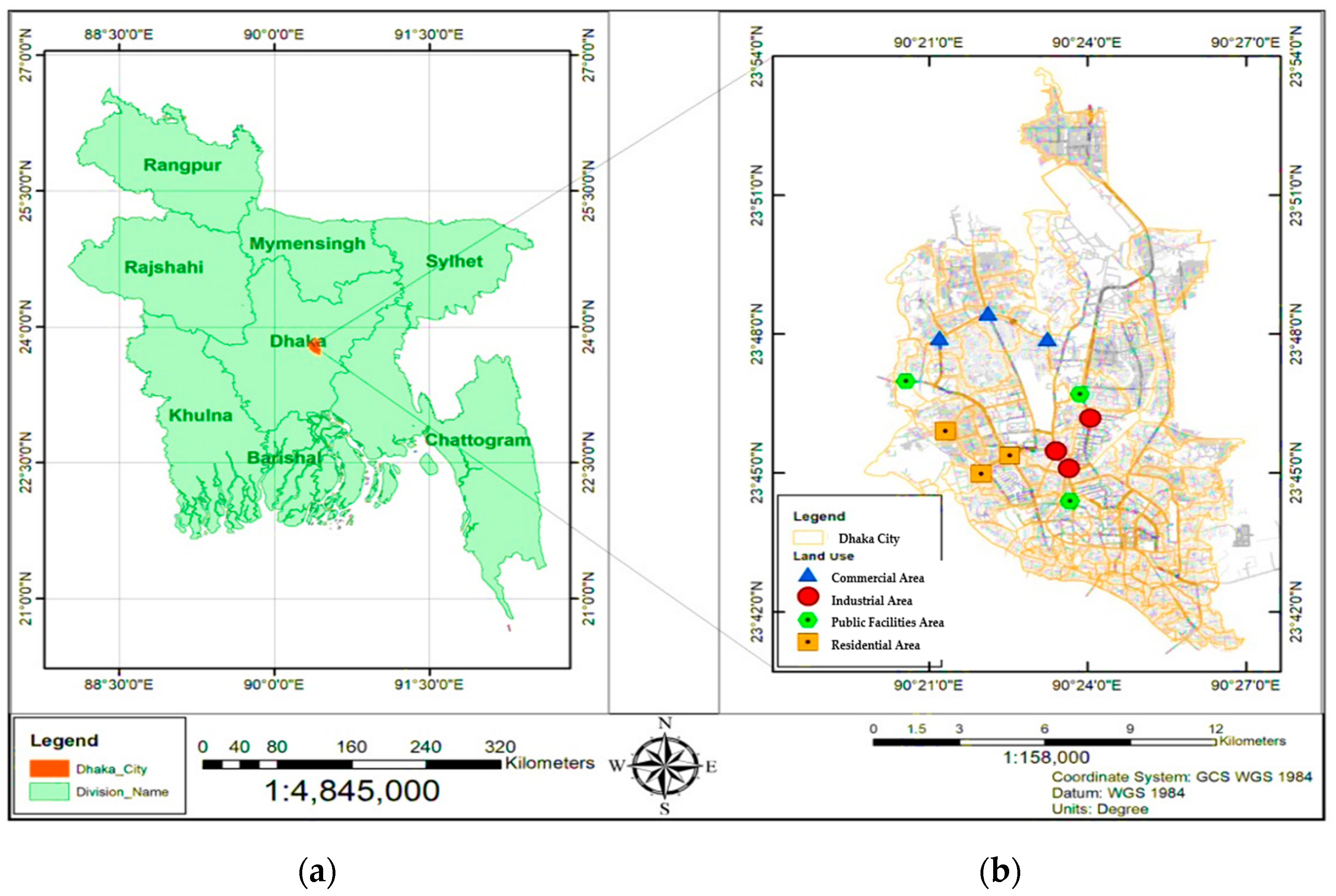

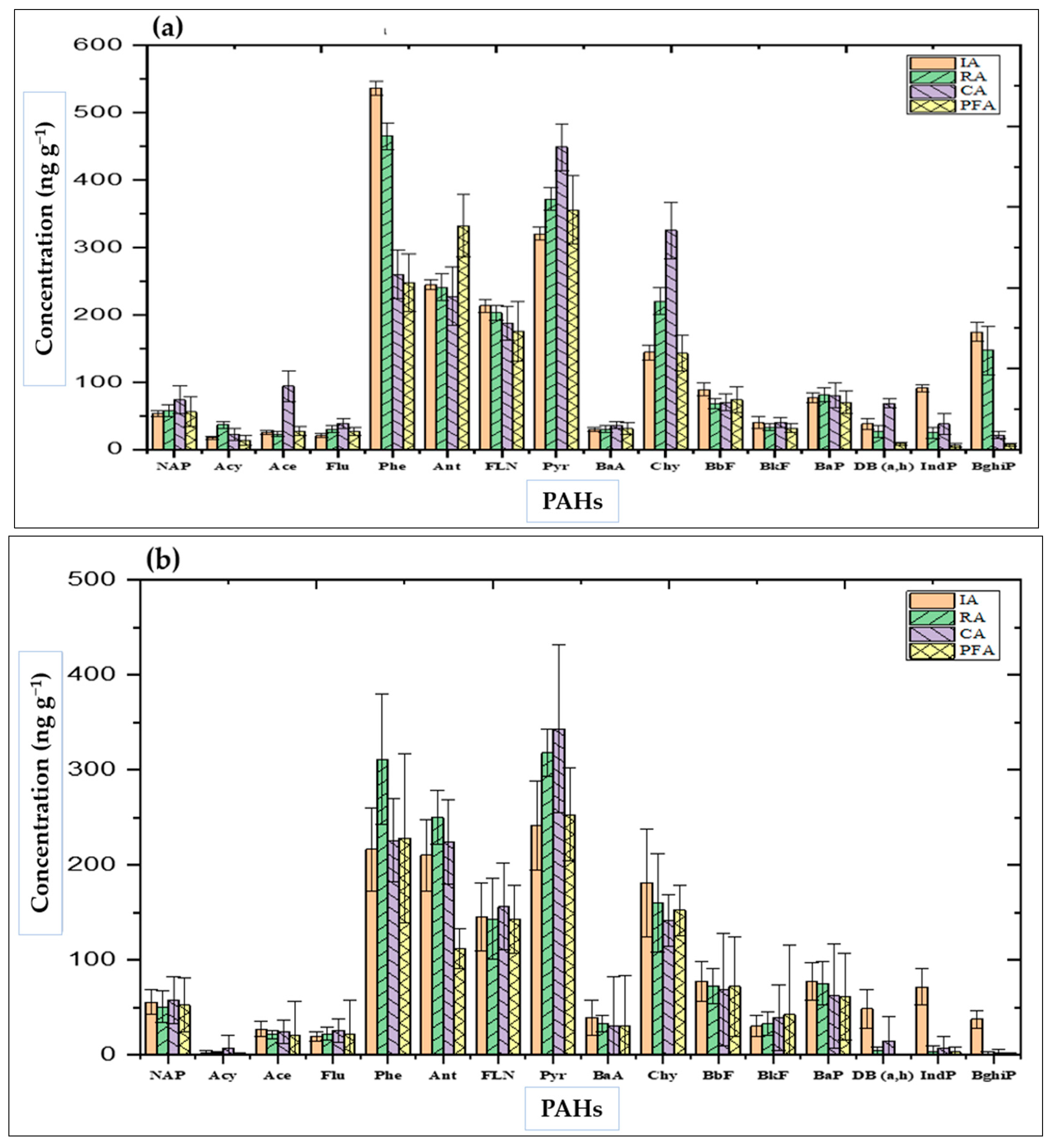
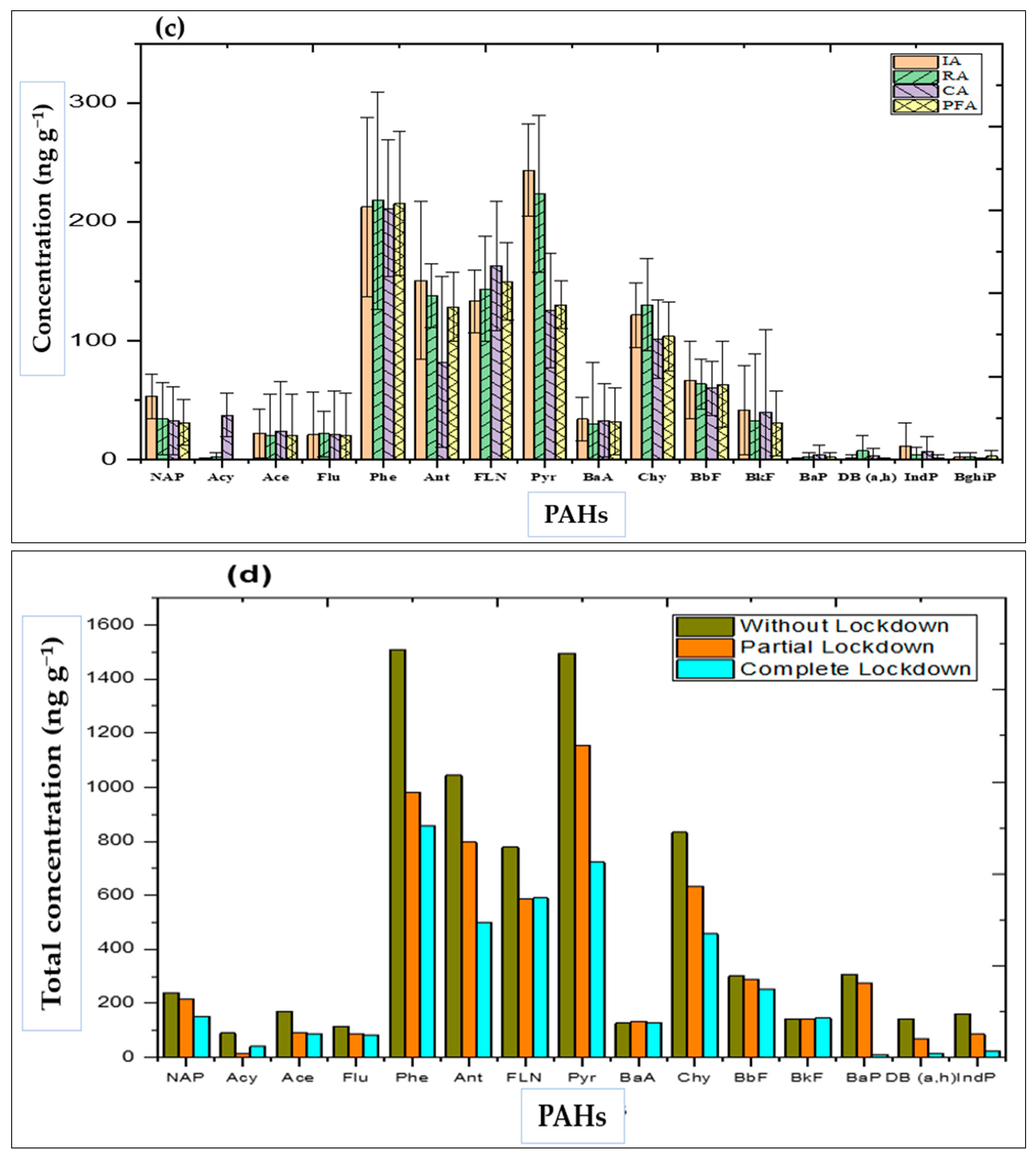
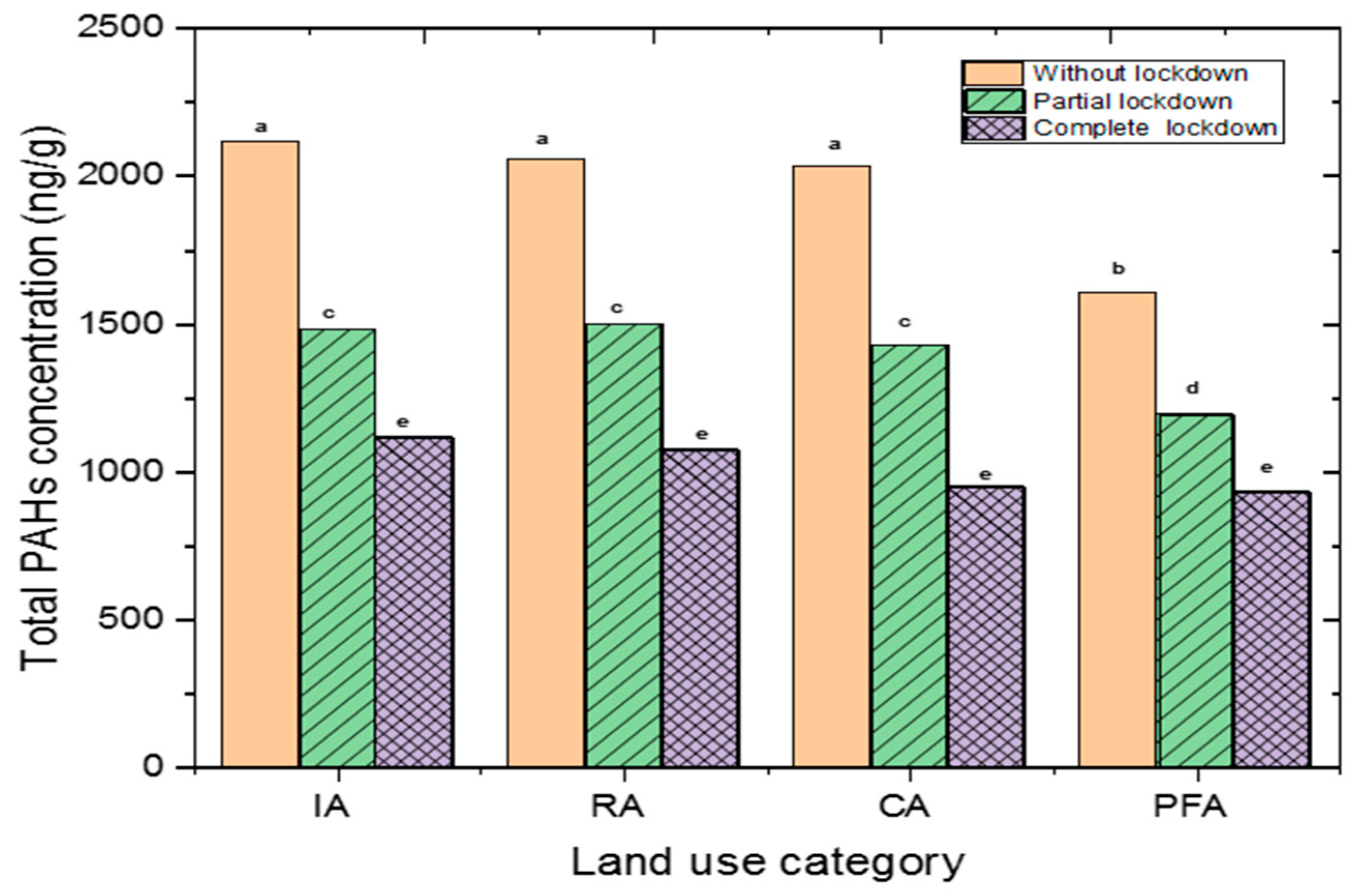
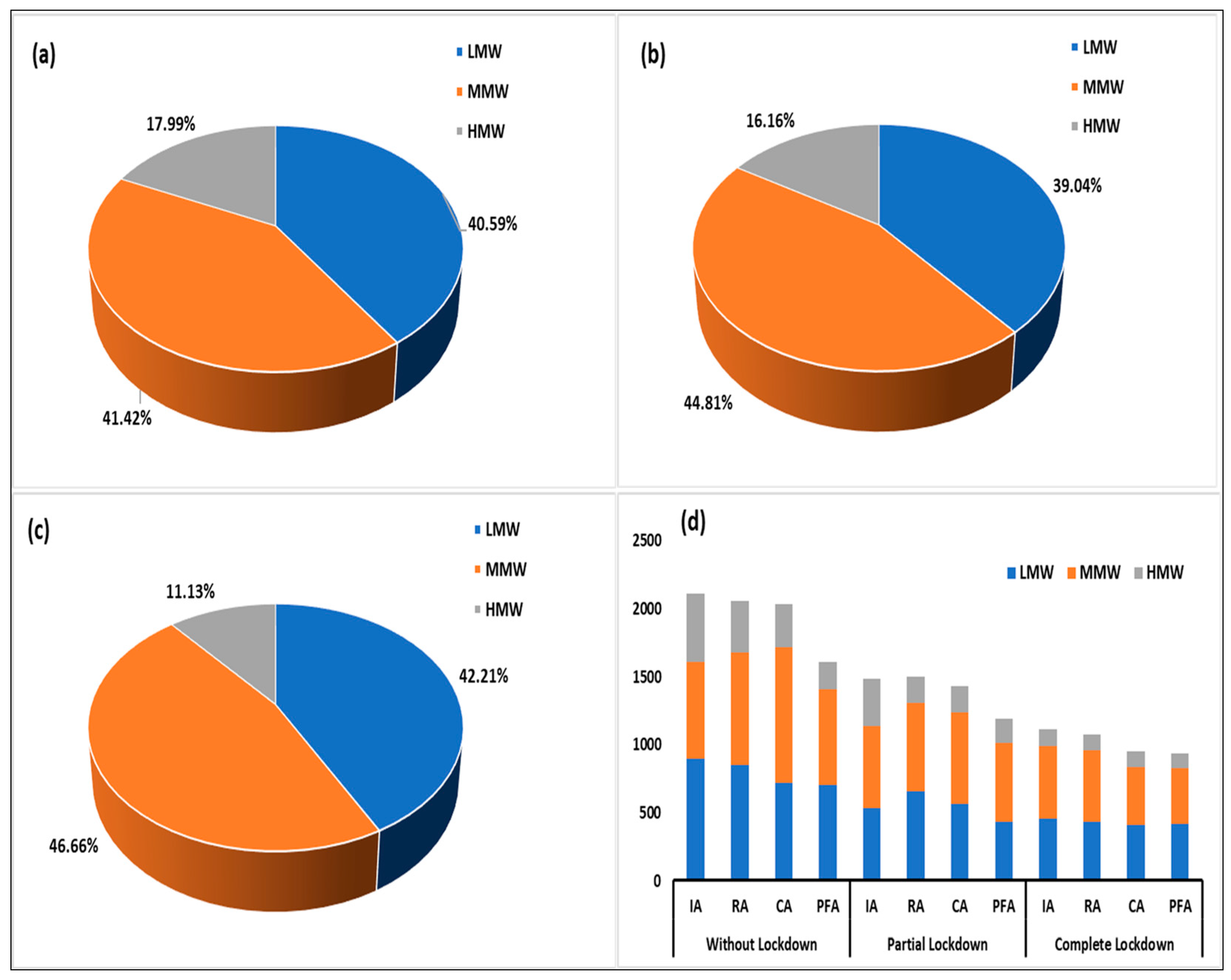



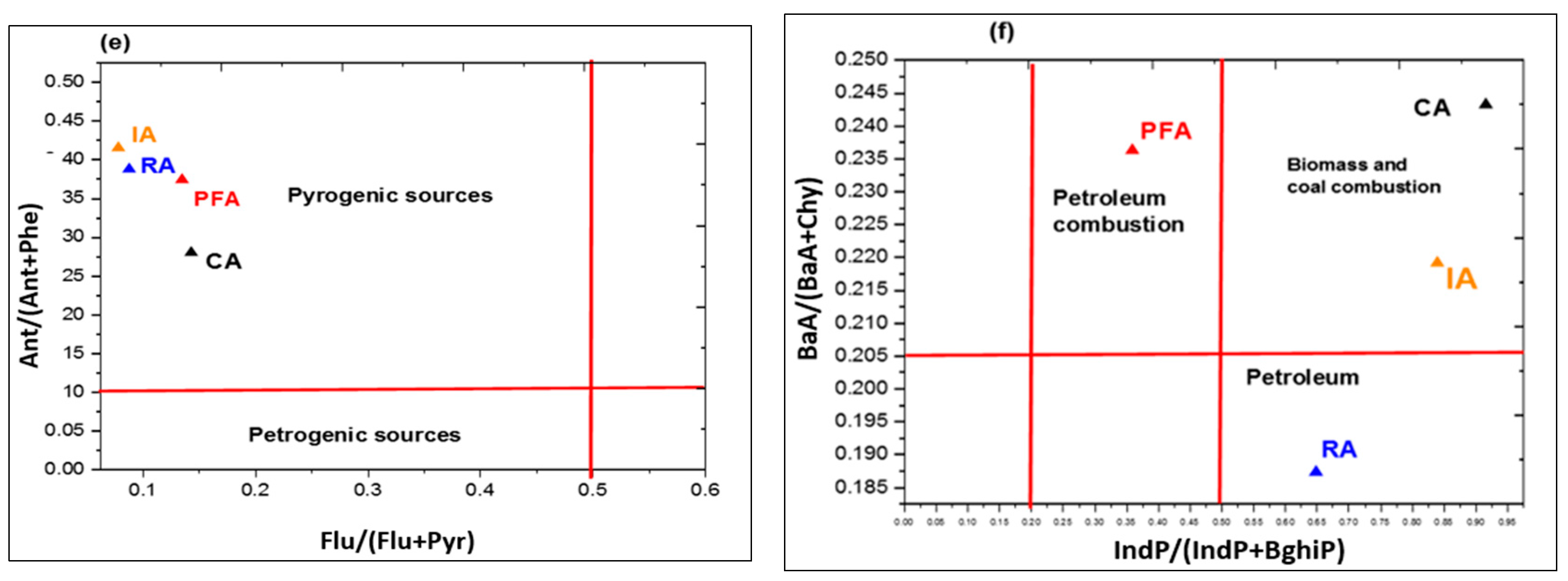
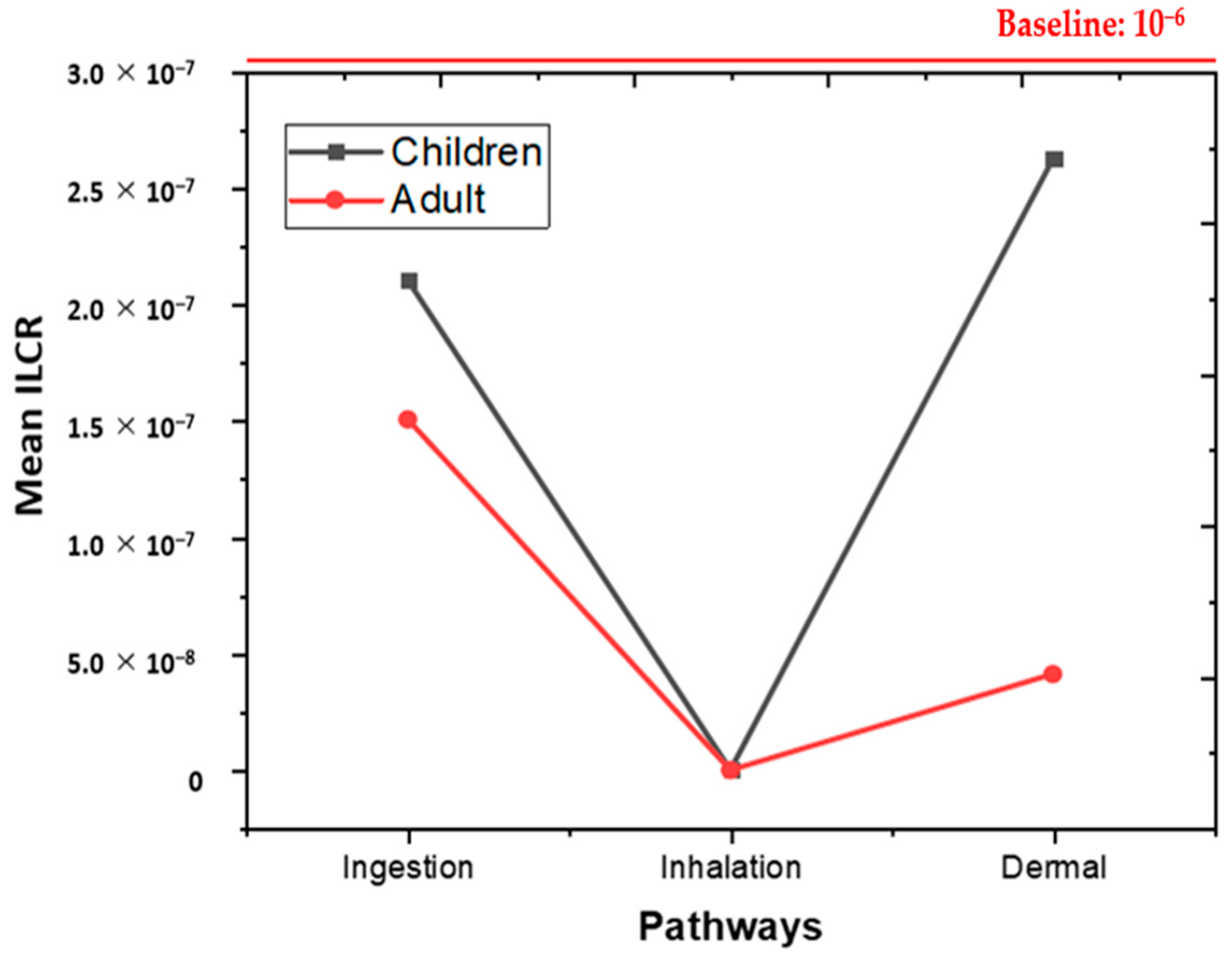
| Compounds | TEFs |
|---|---|
| Nap | 0.001 |
| Acy | 0.001 |
| Ace | 0.001 |
| Flu | 0.001 |
| Phe | 0.001 |
| Ant | 0.01 |
| FLN | 0.001 |
| Pyr | 0.001 |
| BaA | 0.1 |
| Chy | 0.01 |
| BbF | 0.1 |
| BkF | 0.1 |
| BaP | 1 |
| IndP | 0.1 |
| DB (a.h) | 1 |
| BghiP | 0.01 |
| Exposure Variable | Unit | Children (0–6 Years Old) | Adults (7–31 Years Old) |
|---|---|---|---|
| Inhalation rate (IRinh) | m3/d | 10 | 20 |
| Ingestion rate (IRing) | mg/d | 200 | 100 |
| Body weight (BW) | kg | 15 | 70 |
| Exposure frequency (EF) | d/yr | 180 | 180 |
| Exposure duration (ED) | yr | 6 | 24 |
| Average time during exposure (AT) | d | 25,550 | 25,550 |
| Dermal exposure area (SA) | cm2 | 2800 | 5700 |
| Dermal adherence factor (AF) | mg/(cm2 d) | 0.2 | 0.07 |
| Adsorption factor of BaP (ABS) | Unitless | 0.13 | 0.13 |
| Particle emission factor (PEF) | m3/kg | 1.36 × 109 | 1.36 × 109 |
| Carcinogenic slope factor for ingestion (CSFing) | (kg d)/mg | 7.3 | 7.3 |
| Carcinogenic slope factor for dermal contact (CSFdermal) | (kg d)/mg | 25 | 25 |
| Carcinogenic slope factor for inhalation (CSFinh) | (kg d)/mg | 3.85 | 3.85 |
| NAP | Acy | Ace | Flu | Phe | Ant | FLN | Pyr | BaA | Chy | BbF | BkF | BaP | DB (a,h) | IndP | BghiP | |
|---|---|---|---|---|---|---|---|---|---|---|---|---|---|---|---|---|
| Without Lockdown | ||||||||||||||||
| NAP | 1 | |||||||||||||||
| Acy | 0.119 | 1 | ||||||||||||||
| Ace | 0.976 * | −0.052 | 1 | |||||||||||||
| Flu | 0.930 * | 0.329 | 0.831 * | 1 | ||||||||||||
| Phe | −0.591 | 0.373 | −0.565 | −0.648 | 1 | |||||||||||
| Ant | −0.435 | −0.59 | −0.427 | −0.313 | −0.467 | 1 | ||||||||||
| FLN | −0.385 | 0.382 | −0.341 | −0.502 | 0.967* | −0.652 | 1 | |||||||||
| Pyr | 0.976 * | 0.244 | 0.909 * | 0.987 * | −0.634 | −0.372 | −0.459 | 1 | ||||||||
| BaA | 0.977 * | −0.088 | 0.995 * | 0.851 * | −0.642 | −0.343 | −0.431 | 0.920 * | 1 | |||||||
| Chy | 0.951 * | 0.411 | 0.886 * | 0.931 * | −0.384 | −0.624 | −0.183 | 0.957 * | 0.870 * | 1 | ||||||
| BbF | −0.534 | −0.516 | −0.35 | −0.807 | 0.589 * | −0.03 | 0.589 * | −0.702 | −0.398 | −0.598 | 1 | |||||
| BkF | 0.463 | −0.146 | 0.601 * | 0.133 | 0.213 | −0.711 | 0.437 | 0.279 | 0.531 * | 0.437 | 0.457 | 1 | ||||
| BaP | 0.406 | 0.824 * | 0.325 | 0.41 | 0.426 | −0.941 | 0.566 * | 0.416 | 0.255 | 0.652 * | −0.236 | 0.437 | 1 | |||
| DB (a,h) | 0.808 * | 0.133 | 0.860 * | 0.587 * | −0.067 | −0.793 | 0.183 | 0.694 * | 0.807 * | 0.819 * | −0.031 | 0.873 * | 0.635 * | 1 | ||
| IndP | −0.199 | −0.142 | −0.045 | −0.497 | 0.716 * | −0.546 | 0.818 * | −0.376 | −0.128 | −0.161 | 0.853 * | 0.77 | 0.285 | 0.405 | 1 | |
| BghiP | −0.559 | 0.444 | −0.548 | −0.598 | 0.996 * | −0.502 | 0.967 * | −0.591 | −0.626 | −0.335 | 0.526 * | 0.196 | 0.482 | −0.052 | 0.681 * | 1 |
| Partial Lockdown | ||||||||||||||||
| NAP | 1 | |||||||||||||||
| Acy | 0.799 * | 1 | ||||||||||||||
| Ace | 0.763 * | 0.387 | 1 | |||||||||||||
| Flu | 0.35 | 0.815 * | −0.214 | 1 | ||||||||||||
| Phe | − 0.742 | − 0.278 | −0.541 | 0.089 | 1 | |||||||||||
| Ant | 0.154 | 0.431 | 0.376 | 0.269 | 0.504 * | 1 | ||||||||||
| FLN | 0.842 * | 0.992 * | 0.396 | 0.795 * | −0.386 | 0.322 | 1 | |||||||||
| Pyr | 0.163 | 0.720 * | −0.192 | 0.908 * | 0.431 | 0.602 * | 0.650 * | 1 | ||||||||
| BaA | 0.121 | −0.307 | 0.727 * | −0.766 | −0.141 | 0.289 | −0.324 | −0.578 | 1 | |||||||
| Chy | −0.088 | −0.529 | 0.554 * | −0.894 | −0.068 | 0.136 | −0.54 | −0.707 | 0.970 * | 1 | ||||||
| BbF | −0.119 | −0.598 | 0.501 * | − 0.94 | −0.129 | 0.004 | −0.595 | −0.795 | 0.938 * | 0.991 * | 1 | |||||
| BkF | 0.043 | 0.162 | −0.562 | 0.483 | −0.326 | −0.709 | 0.241 | 0.13 | −0.849 | −0.791 | −0.704 | 1 | ||||
| BaP | −0.2 | −0.339 | 0.451 | −0.602 | 0.379 | 0.604 * | −0.415 | −0.244 | 0.856 * | 0.842 * | 0.772 * | −0.983 | 1 | |||
| DB (a,h) | 0.568 * | 0.105 | 0.957 * | −0.485 | −0.485 | 0.282 | 0.115 | −0.427 | 0.884 * | 0.765 * | 0.729 * | −0.667 | 0.602 * | 1 | ||
| IndP | 0.405 | −0.117 | 0.869 * | −0.668 | −0.461 | 0.145 | −0.099 | −0.608 | 0.940 * | 0.872 * | 0.856 * | −0.668 | 0.644 * | 0.974 * | 1 | |
| BghiP | 0.377 | −0.145 | 0.855 * | −0.689 | −0.442 | 0.142 | −0.129 | −0.621 | 0.948 * | 0.887 * | 0.872 * | −0.679 | 0.660 * | 0.967 * | 0.999 * | 1 |
| Complete Lockdown | ||||||||||||||||
| NAP | 1 | |||||||||||||||
| Acy | −0.334 | 1 | ||||||||||||||
| Ace | 0.153 | 0.875 * | 1 | |||||||||||||
| Flu | −0.103 | 0.194 | 0.05 | 1 | ||||||||||||
| Phe | −0.338 | −0.633 | −0.883 | 0.396 | 1 | |||||||||||
| Ant | 0.585 * | −0.949 | −0.71 | −0.065 | 0.503 * | 1 | ||||||||||
| FLN | −0.78 | 0.829* | 0.49 | 0.019 | −0.298 | −0.961 | 1 | |||||||||
| Pyr | 0.746 * | − 0.574 | −0.282 | 0.421 | 0.308 | 0.788 * | −0.885 | 1 | ||||||||
| BaA | 0.680 * | 0.135 | 0.547* | −0.615 | −0.852 | 0.006 | −0.194 | 0.02 | 1 | |||||||
| Chy | 0.436 | −0.575 | −0.46 | 0.637* | 0.606* | 0.723 * | −0.745 | 0.924 * | −0.361 | 1 | ||||||
| BbF | 0.827 * | −0.805 | -0.421 | −0.213 | 0.147 | 0.928 * | −0.977 | 0.791 * | 0.367 | 0.591 * | 1 | |||||
| BkF | 0.698 * | 0.44 | 0.810 * | 0.042 | −0.807 | −0.163 | −0.112 | 0.272 | 0.755 * | −0.025 | 0.176 | 1 | ||||
| BaP | −0.766 | 0.859 * | 0.505 * | 0.241 | −0.219 | −0.953 | 0.974 * | −0.761 | −0.309 | −0.584 | −0.994 | −0.079 | 1 | |||
| DB (a,h) | −0.259 | 0.074 | −0.151 | 0.970* | 0.587* | −0.012 | 0.033 | 0.359 | −0.783 | 0.641 * | − 0.24 | −0.197 | 0.243 | 1 | ||
| IndP | 0.869 * | 0.171 | 0.608 * | 0.055 | −0.651 | 0.125 | −0.392 | 0.516* | 0.741 * | 0.205 | 0.441 | 0.957 * | −0.349 | −0.171 | 1 | |
| BghiP | 0.134 | −0.941 | −0.885 | −0.448 | 0.567* | 0.801* | −0.631 | 0.268 | −0.101 | 0.276 | 0.653 * | −0.584 | −0.726 | −0.291 | −0.367 | 1 |
| Industrial Area | Residential Area | Commercial Area | Public Facilities Area | |||||||||
|---|---|---|---|---|---|---|---|---|---|---|---|---|
| WL | PL | CL | WL | PL | CL | WL | PL | CL | WL | PL | CL | |
| Children | ||||||||||||
| ILCRigestion | 3.54 × 10−7 | 3.69 × 10−7 | 4.30 × 10−8 | 3.13 × 10−7 | 2.35 × 10−7 | 5.60 × 10−8 | 4.20 × 10−7 | 2.28 × 10−7 | 5.15 × 10−8 | 2.34 × 10−7 | 1.86 × 10−7 | 3.73 × 10−8 |
| ILCRinhalation | 6.86 × 10−12 | 7.16 × 10−12 | 8.34 × 10−13 | 6.08 × 10−12 | 4.55 × 10−12 | 1.09 × 10−12 | 8.14 × 10−12 | 4.41 × 10−12 | 9.98 × 10−13 | 4.54 × 10−12 | 3.61 × 10−12 | 7.23 × 10−13 |
| ILCRdermal | 4.41 × 10−7 | 4.60 × 10−7 | 5.36 × 10−8 | 3.91 × 10−7 | 2.93 × 10−7 | 6.98 × 10−8 | 5.23 × 10−7 | 2.84 × 10−7 | 6.41 × 10−8 | 2.92 × 10−7 | 2.32 × 10−7 | 4.65 × 10−8 |
| ILCRtotal | 7.95 × 10−7 | 8.29 × 10−7 | 9.66 × 10−8 | 7.04 × 10−7 | 5.28 × 10−7 | 1.26 × 10−7 | 9.43 × 10−7 | 5.12 × 10−7 | 1.16 × 10−7 | 5.26 × 10−7 | 4.18 × 10−7 | 8.38 × 10−8 |
| Adults | ||||||||||||
| ILCRigestion | 2.53 × 10−7 | 2.64 × 10−7 | 3.08 × 10−8 | 2.24 × 10−7 | 1.68 × 10−7 | 4.01 × 10−8 | 3.01 × 10−7 | 1.63 × 10−7 | 3.68 × 10−8 | 1.68 × 10−7 | 1.33 × 10−7 | 2.67 × 10−8 |
| ILCRinhalation | 9.83 × 10−12 | 1.03 × 10−11 | 1.19 × 10−12 | 8.70 × 10−12 | 6.52 × 10−12 | 1.56 × 10−12 | 1.17 × 10−11 | 6.32 × 10−12 | 1.43 × 10−12 | 6.51 × 10−12 | 5.17 × 10−12 | 1.04 × 10−12 |
| ILCRdermal | 6.93 × 10−8 | 7.23 × 10−8 | 8.43 × 10−9 | 6.14 × 10−8 | 4.60 × 10−8 | 1.10 × 10−8 | 8.22 × 10−8 | 4.46 × 10−8 | 1.01 × 10−8 | 4.59 × 10−8 | 3.65 × 10−8 | 7.30 × 10−9 |
| ILCRtotal | 3.22 × 10−7 | 3.36 × 10−7 | 3.92 × 10−8 | 2.85 × 10−7 | 2.14 × 10−7 | 5.11 × 10−8 | 3.83 × 10−7 | 2.08 × 10−7 | 4.69 × 10−8 | 2.14 × 10−7 | 1.70 × 10−7 | 3.40 × 10−8 |
Publisher’s Note: MDPI stays neutral with regard to jurisdictional claims in published maps and institutional affiliations. |
© 2022 by the authors. Licensee MDPI, Basel, Switzerland. This article is an open access article distributed under the terms and conditions of the Creative Commons Attribution (CC BY) license (https://creativecommons.org/licenses/by/4.0/).
Share and Cite
Rabin, M.H.; Wang, Q.; Wang, W.; Enyoh, C.E. Pollution Characteristics, Source Apportionment, and Health Risk of Polycyclic Aromatic Hydrocarbons (PAHs) of Fine Street Dust during and after COVID-19 Lockdown in Bangladesh. Processes 2022, 10, 2575. https://doi.org/10.3390/pr10122575
Rabin MH, Wang Q, Wang W, Enyoh CE. Pollution Characteristics, Source Apportionment, and Health Risk of Polycyclic Aromatic Hydrocarbons (PAHs) of Fine Street Dust during and after COVID-19 Lockdown in Bangladesh. Processes. 2022; 10(12):2575. https://doi.org/10.3390/pr10122575
Chicago/Turabian StyleRabin, Mominul Haque, Qingyue Wang, Weiqian Wang, and Christian Ebere Enyoh. 2022. "Pollution Characteristics, Source Apportionment, and Health Risk of Polycyclic Aromatic Hydrocarbons (PAHs) of Fine Street Dust during and after COVID-19 Lockdown in Bangladesh" Processes 10, no. 12: 2575. https://doi.org/10.3390/pr10122575






